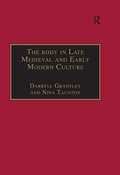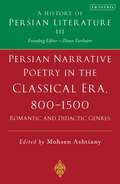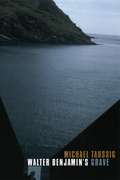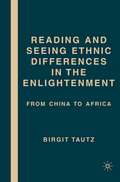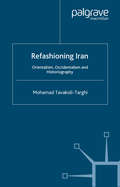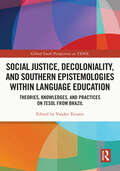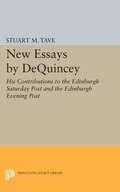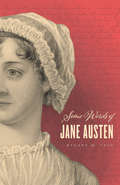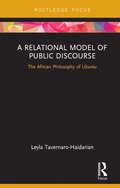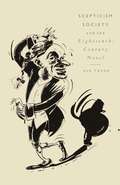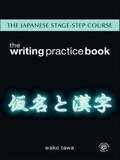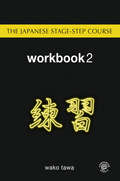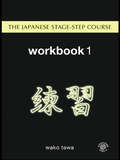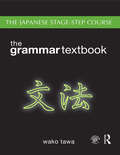- Table View
- List View
The Body in Late Medieval and Early Modern Culture
by Nina TauntonTaking as its chronological starting-point the female body of late medieval devotional literature, the volume moves on to a consideration of the representation of gendered bodies in later literature. It then proceeds to examine sixteenth-century occupational orderings of the (male) body in education, the civil service and the army, and involves explorations into a variety of rituals for the purification, ordering and disciplining of the flesh. It includes enquiries into the miraculous royal body, demon bodies, the 'virtual' body of satire, and ends the late seventeenth century with dramatic representations of the diseased body, and the grotesque bodies of travellers’ tales as signifiers of racial difference. It pushes forward post-modern notions of the body as a site for competing discourses. It provides new dimensions to fantasies, rituals and regulations in narratives ('fictions') of the body as identifications of forms of knowledge unique to the early modern period. Each of the essays sheds new light on how these late medieval and early modern narratives function to produce specialized and discrete languages of the body that cannot be understood simply in terms, say, of religion, philosophy or physiology, but produce their own discrete forms of knowledge. Thus the essays materially contribute to an understanding of the relationship between the body and spatial knowledge by giving new bearings on epistemologies built upon pre-modern perceptions about bodily spaces and boundaries. They address these issues by analysing forms of knowledge constructed through regulations of the body, fantasies about extensions to the body and creations of bodily, psychic, intellectual and spiritual space. The essays pose important questions about how these epistemologies offer different investments of knowledge into structures of power. What constitutes these knowledges? What are the politics of corporeal spaces? In what forms of knowledge about spatial and bodily perceptions and p
Persian Narrative Poetry in the Classical Era, 800-1500: A History of Persian Literature, Vol III (History of Persian Literature)
by I. B. TaurisThe third volume in this ground-breaking series, Persian Narrative Poetry in the Classical Era, 800-1500: Romantic and Didactic Genres, introduces masterpieces of Persian literature from these seven centuries to an international audience. In the process, it underlines the remarkable tenacity of their malleable tradition: the perennial dialogue and the interconnectedness which binds together a vast and varied literature composed of many threads, romantic and didactic, in many lands, from Anatolia and Iran to India and Central Asia. In its companion volume, Persian Lyric in the Classical Era, 800-1500, the readers of the series will have already met in passing all the mythical and historical figures who appear with far more aplomb on the stage here, with their lives narrated in detail by poets of different caliber from different perspectives. The first two chapters of this volume recount the literary history of the entire period, focusing on didactic and romantic narratives. The central chapters take a closer look at the towering figure of the poet Nezâmi Ganjavi. The final chapter takes the reader to a wider landscape tracing the footsteps of Alexander across the globe, offering insights to the cultural preoccupations refracted in so many versions past and present.
Walter Benjamin's Grave
by Michael TaussigIn September 1940, Walter Benjamin committed suicide in Port Bou on the Spanish-French border when it appeared that he and his travelling partners would be denied passage into Spain in their attempt to escape the Nazis. In 2002, one of anthropology’s—and indeed today’s—most distinctive writers, Michael Taussig, visited Benjamin’s grave in Port Bou. The result is “Walter Benjamin’s Grave,” a moving essay about the cemetery, eyewitness accounts of Benjamin’s border travails, and the circumstances of his demise. It is the most recent of eight revelatory essays collected in this volume of the same name. “Looking over these essays written over the past decade,” writes Taussig, “I think what they share is a love of muted and defective storytelling as a form of analysis. Strange love indeed; love of the wound, love of the last gasp.” Although thematically these essays run the gamut—covering the monument and graveyard at Port Bou, discussions of peasant poetry in Colombia, a pact with the devil, the peculiarities of a shaman’s body, transgression, the disappearance of the sea, New York City cops, and the relationship between flowers and violence—each shares Taussig’s highly individual brand of storytelling, one that depends on a deep appreciation of objects and things as a way to retrieve even deeper philosophical and anthropological meanings. Whether he finds himself in Australia, Colombia, Manhattan, or Spain, in the midst of a book or a beach, whether talking to friends or staring at a monument, Taussig makes clear through these marvelous essays that materialist knowledge offers a crucial alternative to the increasingly abstract, globalized, homogenized, and digitized world we inhabit. Pursuing an adventure that is part ethnography, part autobiography, and part cultural criticism refracted through the object that is Walter Benjamin’s grave, Taussig, with this collection, provides his own literary memorial to the twentieth century’s greatest cultural critic.
Walter Benjamin's Grave
by Michael TaussigIn September 1940, Walter Benjamin committed suicide in Port Bou on the Spanish-French border when it appeared that he and his travelling partners would be denied passage into Spain in their attempt to escape the Nazis. In 2002, one of anthropology’s—and indeed today’s—most distinctive writers, Michael Taussig, visited Benjamin’s grave in Port Bou. The result is “Walter Benjamin’s Grave,” a moving essay about the cemetery, eyewitness accounts of Benjamin’s border travails, and the circumstances of his demise. It is the most recent of eight revelatory essays collected in this volume of the same name. “Looking over these essays written over the past decade,” writes Taussig, “I think what they share is a love of muted and defective storytelling as a form of analysis. Strange love indeed; love of the wound, love of the last gasp.” Although thematically these essays run the gamut—covering the monument and graveyard at Port Bou, discussions of peasant poetry in Colombia, a pact with the devil, the peculiarities of a shaman’s body, transgression, the disappearance of the sea, New York City cops, and the relationship between flowers and violence—each shares Taussig’s highly individual brand of storytelling, one that depends on a deep appreciation of objects and things as a way to retrieve even deeper philosophical and anthropological meanings. Whether he finds himself in Australia, Colombia, Manhattan, or Spain, in the midst of a book or a beach, whether talking to friends or staring at a monument, Taussig makes clear through these marvelous essays that materialist knowledge offers a crucial alternative to the increasingly abstract, globalized, homogenized, and digitized world we inhabit. Pursuing an adventure that is part ethnography, part autobiography, and part cultural criticism refracted through the object that is Walter Benjamin’s grave, Taussig, with this collection, provides his own literary memorial to the twentieth century’s greatest cultural critic.
Walter Benjamin's Grave
by Michael TaussigIn September 1940, Walter Benjamin committed suicide in Port Bou on the Spanish-French border when it appeared that he and his travelling partners would be denied passage into Spain in their attempt to escape the Nazis. In 2002, one of anthropology’s—and indeed today’s—most distinctive writers, Michael Taussig, visited Benjamin’s grave in Port Bou. The result is “Walter Benjamin’s Grave,” a moving essay about the cemetery, eyewitness accounts of Benjamin’s border travails, and the circumstances of his demise. It is the most recent of eight revelatory essays collected in this volume of the same name. “Looking over these essays written over the past decade,” writes Taussig, “I think what they share is a love of muted and defective storytelling as a form of analysis. Strange love indeed; love of the wound, love of the last gasp.” Although thematically these essays run the gamut—covering the monument and graveyard at Port Bou, discussions of peasant poetry in Colombia, a pact with the devil, the peculiarities of a shaman’s body, transgression, the disappearance of the sea, New York City cops, and the relationship between flowers and violence—each shares Taussig’s highly individual brand of storytelling, one that depends on a deep appreciation of objects and things as a way to retrieve even deeper philosophical and anthropological meanings. Whether he finds himself in Australia, Colombia, Manhattan, or Spain, in the midst of a book or a beach, whether talking to friends or staring at a monument, Taussig makes clear through these marvelous essays that materialist knowledge offers a crucial alternative to the increasingly abstract, globalized, homogenized, and digitized world we inhabit. Pursuing an adventure that is part ethnography, part autobiography, and part cultural criticism refracted through the object that is Walter Benjamin’s grave, Taussig, with this collection, provides his own literary memorial to the twentieth century’s greatest cultural critic.
Walter Benjamin's Grave
by Michael TaussigIn September 1940, Walter Benjamin committed suicide in Port Bou on the Spanish-French border when it appeared that he and his travelling partners would be denied passage into Spain in their attempt to escape the Nazis. In 2002, one of anthropology’s—and indeed today’s—most distinctive writers, Michael Taussig, visited Benjamin’s grave in Port Bou. The result is “Walter Benjamin’s Grave,” a moving essay about the cemetery, eyewitness accounts of Benjamin’s border travails, and the circumstances of his demise. It is the most recent of eight revelatory essays collected in this volume of the same name. “Looking over these essays written over the past decade,” writes Taussig, “I think what they share is a love of muted and defective storytelling as a form of analysis. Strange love indeed; love of the wound, love of the last gasp.” Although thematically these essays run the gamut—covering the monument and graveyard at Port Bou, discussions of peasant poetry in Colombia, a pact with the devil, the peculiarities of a shaman’s body, transgression, the disappearance of the sea, New York City cops, and the relationship between flowers and violence—each shares Taussig’s highly individual brand of storytelling, one that depends on a deep appreciation of objects and things as a way to retrieve even deeper philosophical and anthropological meanings. Whether he finds himself in Australia, Colombia, Manhattan, or Spain, in the midst of a book or a beach, whether talking to friends or staring at a monument, Taussig makes clear through these marvelous essays that materialist knowledge offers a crucial alternative to the increasingly abstract, globalized, homogenized, and digitized world we inhabit. Pursuing an adventure that is part ethnography, part autobiography, and part cultural criticism refracted through the object that is Walter Benjamin’s grave, Taussig, with this collection, provides his own literary memorial to the twentieth century’s greatest cultural critic.
Walter Benjamin's Grave
by Michael TaussigIn September 1940, Walter Benjamin committed suicide in Port Bou on the Spanish-French border when it appeared that he and his travelling partners would be denied passage into Spain in their attempt to escape the Nazis. In 2002, one of anthropology’s—and indeed today’s—most distinctive writers, Michael Taussig, visited Benjamin’s grave in Port Bou. The result is “Walter Benjamin’s Grave,” a moving essay about the cemetery, eyewitness accounts of Benjamin’s border travails, and the circumstances of his demise. It is the most recent of eight revelatory essays collected in this volume of the same name. “Looking over these essays written over the past decade,” writes Taussig, “I think what they share is a love of muted and defective storytelling as a form of analysis. Strange love indeed; love of the wound, love of the last gasp.” Although thematically these essays run the gamut—covering the monument and graveyard at Port Bou, discussions of peasant poetry in Colombia, a pact with the devil, the peculiarities of a shaman’s body, transgression, the disappearance of the sea, New York City cops, and the relationship between flowers and violence—each shares Taussig’s highly individual brand of storytelling, one that depends on a deep appreciation of objects and things as a way to retrieve even deeper philosophical and anthropological meanings. Whether he finds himself in Australia, Colombia, Manhattan, or Spain, in the midst of a book or a beach, whether talking to friends or staring at a monument, Taussig makes clear through these marvelous essays that materialist knowledge offers a crucial alternative to the increasingly abstract, globalized, homogenized, and digitized world we inhabit. Pursuing an adventure that is part ethnography, part autobiography, and part cultural criticism refracted through the object that is Walter Benjamin’s grave, Taussig, with this collection, provides his own literary memorial to the twentieth century’s greatest cultural critic.
Walter Benjamin's Grave
by Michael TaussigIn September 1940, Walter Benjamin committed suicide in Port Bou on the Spanish-French border when it appeared that he and his travelling partners would be denied passage into Spain in their attempt to escape the Nazis. In 2002, one of anthropology’s—and indeed today’s—most distinctive writers, Michael Taussig, visited Benjamin’s grave in Port Bou. The result is “Walter Benjamin’s Grave,” a moving essay about the cemetery, eyewitness accounts of Benjamin’s border travails, and the circumstances of his demise. It is the most recent of eight revelatory essays collected in this volume of the same name. “Looking over these essays written over the past decade,” writes Taussig, “I think what they share is a love of muted and defective storytelling as a form of analysis. Strange love indeed; love of the wound, love of the last gasp.” Although thematically these essays run the gamut—covering the monument and graveyard at Port Bou, discussions of peasant poetry in Colombia, a pact with the devil, the peculiarities of a shaman’s body, transgression, the disappearance of the sea, New York City cops, and the relationship between flowers and violence—each shares Taussig’s highly individual brand of storytelling, one that depends on a deep appreciation of objects and things as a way to retrieve even deeper philosophical and anthropological meanings. Whether he finds himself in Australia, Colombia, Manhattan, or Spain, in the midst of a book or a beach, whether talking to friends or staring at a monument, Taussig makes clear through these marvelous essays that materialist knowledge offers a crucial alternative to the increasingly abstract, globalized, homogenized, and digitized world we inhabit. Pursuing an adventure that is part ethnography, part autobiography, and part cultural criticism refracted through the object that is Walter Benjamin’s grave, Taussig, with this collection, provides his own literary memorial to the twentieth century’s greatest cultural critic.
Reading and Seeing Ethnic Differences in the Enlightenment: From China to Africa
by B. TautzThis book investigates the contested ways in which eighteenth-century German philosophers, scientists, poets, and dramatists perceived and represented China and Africa from 1680 to 1830. Tautz demonstrates in compelling ways that reading China allowed for the integration of cultural difference into Enlightenment universalism, whereas seeing Africa exposed irreducible differences that undermined any claims of universality. By working through the case of eighteenth-century Germany and Europe, the book adds an important cross-cultural and historical dimension to questions relevant to our world today.
Refashioning Iran: Orientalism, Occidentalism and Historiography (St Antony's Series)
by M. Tavakoli-TarghiMohamad Tavakoli-Targhi offers a corrective to recent works on Orientalism that focus solely on European scholarly productions without exploring the significance of native scholars and vernacular scholarship to the making of Oriental studies. He brings to light a wealth of eighteenth- and nineteenth-century Indo-Persian texts, made 'homeless' by subsequent nationalist histories and shows how they relate to Indo-Iranian modernity. In doing so, he argues for a radical rewriting of Iranian history with profound implications for Islamic debates on gender.
Social Justice, Decoloniality, and Southern Epistemologies within Language Education: Theories, Knowledges, and Practices on TESOL from Brazil (Global South Perspectives on TESOL)
by Vander TavaresWith a strong focus on decoloniality and social justice, this volume brings together critical theories, concepts, and practices on TESOL from multiple Brazilian perspectives. The chapters showcase the work of teachers and teacher educators in confronting sociopolitical issues in Brazil, including in the domains of democracy, language education, and knowledge production, as well as prevailing issues within TESOL itself. Contributions stem from an eclectic range of analytical orientations that reflect ontological and epistemological diversity while demonstrating why, where, and how TESOL is done in Brazil. In doing so, this volume also establishes a place for Southern voices to be heard in the move toward challenging complex and long-standing issues of representation, marginalization, and exclusion that have traditionally characterised North-South relations in TESOL as a field. This volume seeks to promote Southern-based conversations about decoloniality and social justice in TESOL and will be of direct relevance to graduate students, researchers, and scholars in the field of TESOL and foreign language education.
Social Justice, Decoloniality, and Southern Epistemologies within Language Education: Theories, Knowledges, and Practices on TESOL from Brazil (Global South Perspectives on TESOL)
by Vander TavaresWith a strong focus on decoloniality and social justice, this volume brings together critical theories, concepts, and practices on TESOL from multiple Brazilian perspectives. The chapters showcase the work of teachers and teacher educators in confronting sociopolitical issues in Brazil, including in the domains of democracy, language education, and knowledge production, as well as prevailing issues within TESOL itself. Contributions stem from an eclectic range of analytical orientations that reflect ontological and epistemological diversity while demonstrating why, where, and how TESOL is done in Brazil. In doing so, this volume also establishes a place for Southern voices to be heard in the move toward challenging complex and long-standing issues of representation, marginalization, and exclusion that have traditionally characterised North-South relations in TESOL as a field. This volume seeks to promote Southern-based conversations about decoloniality and social justice in TESOL and will be of direct relevance to graduate students, researchers, and scholars in the field of TESOL and foreign language education.
New Essays by De Quincey: His Contributions to the Edinburgh Saturday Post and the Edinburgh Evening Post
by Stuart M. TaveThis is the first time these essays have been collected and identified as De Quincey's. Each essay or article is reprinted with full annotation and the author’s reasons for attributing it to De Quincey. The essays vary in length and in subject matter: some are addressed to "The Editor"; some are critical reviews of contemporary magazines; some are week-to-week political commentaries on issues facing the second Tory party. Together they show De Quincey, the journalist, working on a variety of subjects that occur in his writing before and after this time, from the financing of empires to an attack on Macaulay or an analysis of Burke’s mind and style.Originally published in 1966.The Princeton Legacy Library uses the latest print-on-demand technology to again make available previously out-of-print books from the distinguished backlist of Princeton University Press. These editions preserve the original texts of these important books while presenting them in durable paperback and hardcover editions. The goal of the Princeton Legacy Library is to vastly increase access to the rich scholarly heritage found in the thousands of books published by Princeton University Press since its founding in 1905.
Some Words of Jane Austen
by Stuart M. TaveJane Austen’s readers continue to find delight in the justness of her moral and psychological discriminations. But for most readers, her values have been a phenomenon more felt than fully apprehended. In this book, Stuart M. Tave identifies and explains a number of the central concepts across Austen’s novels—examining how words like “odd,” “exertion,” and, of course, “sensibility,” hold the key to understanding the Regency author’s language of moral values. Tracing the force and function of these words from Sense and Sensibility to Persuasion, Tave invites us to consider the peculiar and subtle ways in which word choice informs the conduct, moral standing, and self-awareness of Austen’s remarkable characters.
Some Words of Jane Austen
by Stuart M. TaveJane Austen’s readers continue to find delight in the justness of her moral and psychological discriminations. But for most readers, her values have been a phenomenon more felt than fully apprehended. In this book, Stuart M. Tave identifies and explains a number of the central concepts across Austen’s novels—examining how words like “odd,” “exertion,” and, of course, “sensibility,” hold the key to understanding the Regency author’s language of moral values. Tracing the force and function of these words from Sense and Sensibility to Persuasion, Tave invites us to consider the peculiar and subtle ways in which word choice informs the conduct, moral standing, and self-awareness of Austen’s remarkable characters.
Some Words of Jane Austen
by Stuart M. TaveJane Austen’s readers continue to find delight in the justness of her moral and psychological discriminations. But for most readers, her values have been a phenomenon more felt than fully apprehended. In this book, Stuart M. Tave identifies and explains a number of the central concepts across Austen’s novels—examining how words like “odd,” “exertion,” and, of course, “sensibility,” hold the key to understanding the Regency author’s language of moral values. Tracing the force and function of these words from Sense and Sensibility to Persuasion, Tave invites us to consider the peculiar and subtle ways in which word choice informs the conduct, moral standing, and self-awareness of Austen’s remarkable characters.
Some Words of Jane Austen
by Stuart M. TaveJane Austen’s readers continue to find delight in the justness of her moral and psychological discriminations. But for most readers, her values have been a phenomenon more felt than fully apprehended. In this book, Stuart M. Tave identifies and explains a number of the central concepts across Austen’s novels—examining how words like “odd,” “exertion,” and, of course, “sensibility,” hold the key to understanding the Regency author’s language of moral values. Tracing the force and function of these words from Sense and Sensibility to Persuasion, Tave invites us to consider the peculiar and subtle ways in which word choice informs the conduct, moral standing, and self-awareness of Austen’s remarkable characters.
A Relational Model of Public Discourse: The African Philosophy of Ubuntu (Routledge Focus on Communication Studies)
by Leyla Tavernaro-HaidarianContemporary democratic discourses are frequently, though not exclusively, characterized by an attitude of ‘pro and con' where the aim is to persuade others, a jury or an audience, of what is right and what is wrong. Challenging such procedures, this book teases out an alternative model of public discourse that is based in collaboration and deliberation. The African philosophy of ubuntu offers valuable insights in this regard as it implies relational notions of power that contrast and complement individualist facets. It provides the space to think and speak in ways that support harmonious and cohesive societal structures and practices. The book’s model of communication rests on the premise that the various interests of individuals and groups, while richly diverse, can be conceived of as profoundly bound-up rather than incompatible. In this way communication enables broader lines of action and a wider scope for achieving diversity and common ground.
A Relational Model of Public Discourse: The African Philosophy of Ubuntu (Routledge Focus on Communication Studies)
by Leyla Tavernaro-HaidarianContemporary democratic discourses are frequently, though not exclusively, characterized by an attitude of ‘pro and con' where the aim is to persuade others, a jury or an audience, of what is right and what is wrong. Challenging such procedures, this book teases out an alternative model of public discourse that is based in collaboration and deliberation. The African philosophy of ubuntu offers valuable insights in this regard as it implies relational notions of power that contrast and complement individualist facets. It provides the space to think and speak in ways that support harmonious and cohesive societal structures and practices. The book’s model of communication rests on the premise that the various interests of individuals and groups, while richly diverse, can be conceived of as profoundly bound-up rather than incompatible. In this way communication enables broader lines of action and a wider scope for achieving diversity and common ground.
Japanese Stage-Step Course: Writing Practice Book
by Wako TawaThe Writing Practice Book provides a step-by-step guide to writing Kana and Kanji. It is designed to give maximum flexibility to users of The Japanese Stage-Step Course and enables students to learn, practice and perfect their writing skills at their own pace. The book is divided into two parts; the first focuses on Kana and the second on Kanji. There are clear instructions on stroke order followed by tracing exercises and plenty of boxes are provided for additional practice. Kanji are gradually introduced in sets and are accompanied by the Japanese readings, examples of usage and radicals.
The Japanese Stage-Step Course: Workbook 2
by Wako TawaWorkbook 2 of the Japanese Stage-Step Course is designed to be used alongside Stages Two and Three of the Grammar Textbook. It contains conversation, listening, reading and writing exercises along with new vocabulary for each lesson in the textbook to enable students to thoroughly practice the grammatical structures they have learnt. Additional features include: detailed explanation of vocabulary items abundant exercises including sentence as well as discourse practices extensive cross-referencing with the Grammar Textbook Japanese–English and English–Japanese glossary. All the audio material for Workbook 2 is available on CD2.
The Japanese Stage-Step Course: Workbook 2
by Wako TawaWorkbook 2 of the Japanese Stage-Step Course is designed to be used alongside Stages Two and Three of the Grammar Textbook. It contains conversation, listening, reading and writing exercises along with new vocabulary for each lesson in the textbook to enable students to thoroughly practice the grammatical structures they have learnt. Additional features include: detailed explanation of vocabulary items abundant exercises including sentence as well as discourse practices extensive cross-referencing with the Grammar Textbook Japanese–English and English–Japanese glossary. All the audio material for Workbook 2 is available on CD2.
Japanese Stage-Step Course: Workbook 1
by Wako TawaWorkbook 1 of the Japanese Stage-Step Course is designed to be used alongside Stage One of the Grammar Textbook. It contains grammar exercises, along with new vocabulary and conversational, listening, and reading practice for each chapter in the textbook, so that students will be able to thoroughly practice the grammatical structures they have learnt. Additional features include: detailed explanation of vocabulary items information on the system of Kanji abundant exercises including sentence as well as discourse practices extensive cross-referencing with the Grammar Textbook Japanese-English and English-Japanese glossary. All the audio material for Workbook 1 is available on CD1.
Japanese Stage-Step Course: Grammar-Reference
by Wako TawaThe Japanese Stage-Step Course is a fully integrated language course from beginner through to intermediate level combining cohesive grammar instruction with functional examples and practices to build a solid foundation in the four key skills of reading, writing, listening and speaking. The course includes the core text, The Grammar Textbook, Workbooks 1 and 2, Writing Practice Book, audio material on CDs or in MP3 format, and a Companion Website. An understanding of grammar is essential for students aiming to achieve a high level of proficiency in Japanese. Written by an experienced teacher, The Stage-Step Course: Grammar Textbook provides a step-by-step guide to Japanese grammar. With clear, accessible explanations and relevant examples to put each grammatical point into context, the Grammar provides a meaningful framework to develop the key skills of reading, writing, speaking and listening. The book is divided into the following four stages: Stage One: Building a foundation. Stage Two: Towards more complex structures. Stage Three: Adding sophistication. Stage Four: Referencing. Each lesson is accompanied by detailed vocabulary, conversation practice and reading exercises in the separate two workbooks to enable students to put into practice what they have learnt and consolidate their knowledge. The course also includes the Writing Practice Book, audio material on CDs or in MP3 format and a Companion Website.
